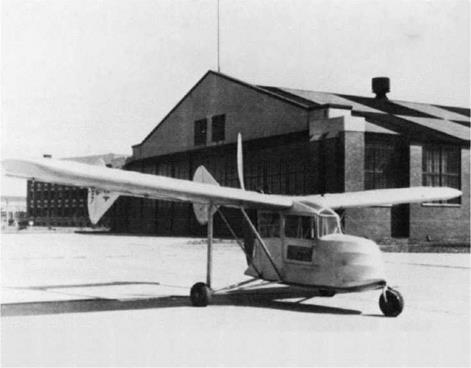Early Safe Personal Airplane Designs
Aeromarine-Klemm As imported from Germany, it had unsafe spin characteristics. The wing was modified to have less taper and thicker tip sections. Control movement was restricted, and the center of gravity range was moved forward. All of these modifications, apparently arrived at empirically, were in a direction to improve spin resistance, and this airplane became one of the very first to be called incapable of spinning. Actually, a spin could be forced, but the airplane had to be held into the spin; and with free controls it would recover. Aeromarine-Klemm models were produced with several different engines from the late 1920s to 1932.
Stout Sky Car Designed in 1931, the Sky Car was one of the first two-control airplanes. It had floating wing tip ailerons that were weight overbalanced, making them float symmetrically with slight negative lift. When deflected for a roll, proverse yaw, or yaw in the direction of the roll, resulted. No rudder control was needed to coordinate the roll. The Sky Car had a tricycle landing gear and limited up-elevator travel. It was a stubby, odd-looking machine, a biplane with a small vertical tail.
Weick W-1A In 1935 and 1936, this airplane was a test bed for several safety innovations. It had full-span flaps that could be deflected to 80 degrees to make steep descents into small fields. Slot lip spoilers provided lateral control (Figure 15.2). The not-yet-famous Robert T Jones studied two-control operation and told Weick that the W-1A’s spoiler ailerons would be ideal for the purpose, as they turned out to be. As in the Stout Sky Car, elevator control was limited to prevent stall.
Stearman-Hammond Model Y and the Gwinn Aircar Both of these airplanes were designed with features of the Weick W-1A. The Model Y won a safe airplane competition sponsored by the Department of Commerce. The Aircar had no rudder at all. Its interior looked like an Oldsmobile, with Oldsmobile steering wheel and instruments.
ERCO Model 310 and the Ercoupe Fred Weick’s Ercoupe was the only one of the early safe airplanes to make it into production, which started in 1940 (Figure 15.3). The Ercoupe has the two-control, restricted elevator control and tricycle landing gear features ofthe W-1 A. The U. S. Civil Aeronautics Authority certified the Ercoupe as “characteristically incapable of spinning” and cut the dual time required to solo from 8 to 5 hours and the time for private pilot certification from 35 to 25 hours.
With the yoke hard back, rapid full aileron control deflections from side to side produce nothing more exciting than falling-leaf motions. Cross-wind touchdowns are made with the airplane headed into the relative wind. When the pilot releases the controls the Ercoupe straightens out for its ground roll.
|
Figure 15.2 The 1935 Weick W-1A airplane, photographed in front of an NACA Langley Field hangar. This innovative airplane had full-span flaps and spoiler ailerons, limited up-elevator travel, and two-control operation. (From Weick, From the Ground Up, 1988) |















